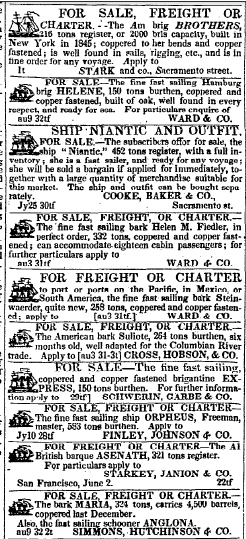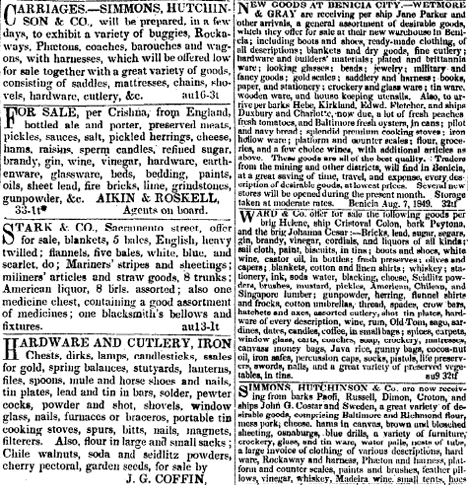News & Tall Tales. 1800s.

Money Will Buy Anything
Ships were the main source of supply for California Pioneers. Absolutely everything was available in San Francisco from the hundreds of ships that began arriving within months of the discovery of gold. Among the smart fortune seekers were the ship owners. To be sure, shipping was high risk, but potentially extremely lucrative.
 If the ship didn’t go down along the perilous routes to California, owners stood to make up to $800,000 from merchandise. Often, once the merchandise was sold, they also sold the ships.
If the ship didn’t go down along the perilous routes to California, owners stood to make up to $800,000 from merchandise. Often, once the merchandise was sold, they also sold the ships.
Equally good at business were the merchants with storehouses where they auctioned goods to the residents of San Francisco. Starkey, Janion & Co was but one of the companies and in an April 12, 1849 ad in the Alta California, the company offered the following from the bark Asenath.
What isn’t on this list, but is on many others, are exotic fruits and vegetables and liquors from around the world. The range is amazing and as often as one wonders "what is that," one might ask "they had those then?
NEW GOODS
Now landing from bark Asenath direct from Liverpool, expressly selected for the California markets, and for sales on reasonable terms, by the undersigned:
Dry goods. 31 to 37 inches white sheetings, 7-8 and 9-8 two blue prints, cotton bed ticking, union plain and colored drills, Denims, as’d plain and fig’d summer cloths, 72 and 74 inch green billiard cloths, 9-8 col’d fancy prints, 7-8 chintz furniture do., 9-8 col’d muslins, 9-8 plain turkey reds, 7-8 d’laine dresses, woolen cloths, plain and regatta shirts, slops, woolen caps, blankets, bayetas, mottled and fancy drills, lastings, cape do., princettas, imperial crapes, panos de costa, romales, grandrells, imitation Venetian blinds, blue pilots, green baizes, mixed cassinetts, carpeting, fancy union tweeds, a’d fustians, gloves, hosiery, cotton and union fringes, as’d laces, candlewick, silk velvet, silk handkerchiefs, check and book muslin’s, suspenders, as’d parasols and umbrellas, lute string and satin ribbons, sewing cotton, longcloths, fancy vestings, serges, Hollands, diaper, huckaback cloutings, linens, osnaburgs.

Tools Used by a Shoemaker or Cobbler Hardware, tinware, &c. As’d rod, hoop and sheet iron, iron gates, do. Pumps, ploughs, iron wire, tin plates, shovels, pickaxes, mattocks, vices, blued shingling, wedge and broad axes, saws, carpenter’s adz, hammers, firmer and socket chisels, sash tools, files, spokeshaves, gimlets, planes, screw drivers, coach wrenches, bracebitts, compasses, box rules, iron squares, screws, nails as’d locks and bolts, hooks and hinges, "I" do., glue, iron wire and staples, sad irons, fenders, fire irons, marble chimney pieces, stoves, lamps, lanthorns, fowling pieces, powder flasks, shot belts, percussion caps, glaziers diamonds, silver pencil cases, neck beads, thimbles, brad and shoe awls, hat and coat hooks, hunting spurs, brass candlesticks, spring dividers, brass wire ware, Spanish marks, tea and table spoons, C.S. shoe tacks, pins, sail needles, fish hooks, brass taps, curtain rings, brass chair nails, scissors, pen and pocket knives, razors, table knives and forks, camp kettles, fish kettles, tea do., sauce pan digesters, bakepans and ovens, stew and sauce pans, funnels’ scoops, graters, soup tureens, as’d shoemakers tools, and a great variety of other articles.
Earthenware. Consisting of as’d soup and dinner plates, bowls, jugs, cups and saucers, ewers and basins, dishes, teapots, &c.
Naval stores, groceries, wines, etc. Paints, paint oil, tar, refined sugar, currants, mustard, cheese, as’d pickles, pepper and vinegar, sauces, preserved meats.
Sherry and port wine, champagne, claret, Geneva, brandy, rum, ale, porter. Pipes, medio floreta paper, slates, bricks, coal, tobacco.
STARKEY, JANION & CO.
April 12, 1849 from the Alta California
August 16, 1849, Alta California, San Francisco

| Bird's Eye View of the Village of San Francisco. 1800s. M & N Hanhart Chromo Lithograph Co. |
 All About America: Gold Rush and Riches
All About America: Gold Rush and Riches
Paul Robert Walker
Meticulously researched, with specially-commissioned illustrations and original artwork from each period, reading lists, resources for further study. An immersive introduction to the history that shaped America. In 1848, carpenter James Marshall made a chance discovery: a few shiny flakes-of gold in a riverbed he was digging. Within a year 800,000 gold-seekers from all over the world were on their way to California. The Gold Rush was on.
Freaks of Fortune: The Emerging World of Capitalism and Risk in America
Jonathan Levy
Until the early nineteenth century, "risk" was a specialized term: it was the commodity exchanged in a marine insurance contract. Here is a story of how the modern concept of risk emerged in the United States. Born on the high seas, risk migrated inland and became essential to the financial management of an inherently uncertain capitalist future. Focusing on the hopes and anxieties of ordinary people, Levy shows how risk developed through extraordinary growth of new financial institutions - insurance corporations, savings banks, mortgage-backed securities markets, commodities futures markets, securities markets - while posing moral questions. To be a free individual, whether an emancipated slave, a plains farmer, or a Wall Street financier, was to take, assume, and manage one's own personal risk. Yet this often meant offloading that same risk onto a series of new financial institutions. Levy traces the fate of personal freedom as it unfolded in the new economic reality created by the American financial system.
 Imperial San Francisco: Urban Power, Earthly Ruin
Imperial San Francisco: Urban Power, Earthly Ruin
(California Studies in Critical Human Geography)
Gray Brechin
First published in 1999, this history of San Francisco traces the exploitation of both local and distant regions by prominent families — the Hearsts, de Youngs, Spreckels, and others who gained power through mining, ranching, water and energy, transportation, real estate, weapons, and mass media. The story is one of greed and ambition on an epic scale, tracing the connections between environment, economy, and technology with links that led, ultimately, to the creation of the atomic bomb and the nuclear arms race.
 The Big Spenders:
The Epic Story of the Rich Rich, the Grandees of America and the Magnificoes, and How They Spent Their Fortunes
The Big Spenders:
The Epic Story of the Rich Rich, the Grandees of America and the Magnificoes, and How They Spent Their Fortunes
Lucius Beebe
The Big Spenders was Lucius Beebe's last and many think his best book. Here he describes the consumption of the Gilded Age. Beebe enjoys it all immensely, and so do his readers, whether it is James Gordon Bennett buying a Monte Carlo restaurant because he was refused a seat by the window, or Spencer Penrose leaving a bedside memo reminding himself not to spend more than $1 million the next day.
Millionaires and Kings of Enterprise
The Marvellous Careers of Some Americans Whose Pluck, Foresight, and Energy Have Made Themselves Masters in the Fields of Industry and Finance
James Burnley
 The Tycoons: How Andrew Carnegie, John D. Rockefeller, Jay Gould, and J. P. Morgan Invented the American Supereconomy
The Tycoons: How Andrew Carnegie, John D. Rockefeller, Jay Gould, and J. P. Morgan Invented the American Supereconomy
Charles R. Morris
The acclaimed author vividly brings the men and their times to life. The ruthlessly competitive Carnegie, the imperial Rockefeller, and the provocateur Gould were obsessed with progress, experiment, and speed. They were balanced by Morgan, the gentleman businessman, who fought for a global trust in American business. Through antagonism and their verve, they built an industrial behemoth — and a country of middle-class consumers. These four determined men wrenched the economy into the modern age, inventing a nation of full economic participation not imagined a few decades earlier.


 Copyright ~ 1998-2018.
Copyright ~ 1998-2018. 